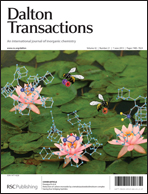This paper introduces the formation reactions and reaction mechanisms of a series of potassium niobates from a potassium salt of the Lindquist hexaniobate [Nb6O19]8− ion under solvothermal conditions. The structure and particle morphology of the potassium niobate product can be controlled easily with the reaction solution alkalinity using this solvothermal process. KNb3O8 with a plate-like morphology, K4Nb6O17·4.5H2O with a plate-like morphology, a new phase of K2Nb2O6·H2O with fibrous morphology, KNbO3 perovskites with cubic morphology are obtained at pH = 5.5, and in 0.3, 0.5, 1.0 mol L−1 KOH solutions at 230 °C, respectively. The reaction conditions are much milder than those in the normal hydrothermal process. Furthermore, the K2Nb2O6·H2O fibers can be topotactically transformed into KNbO3 fibers, Nb2O5 fibers after H+-exchange-treatment, and LiNbO3 fibers after Li+-exchange-treatment by heat-treatments at 730, 560, and 520 °C, respectively. The formation reaction and structure of these potassium niobates were characterized by X-ray diffraction (XRD), scanning electron microscopy (SEM), transmission electron microscopy (TEM), selected-area electron diffraction (SAED), energy-dispersive spectroscopy (EDS), Raman spectra and TG-DTA. The formation mechanism of this series of potassium niobates from the [Nb6O19]8− precursor is systematically explained via the correlation between the octahedrons [NbO6] sharing forms in the precursor structure and in the product structures.


 Please wait while we load your content...
Please wait while we load your content...